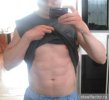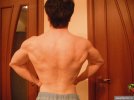What you are espousing is not 'HST'. You've removed half of the periodisation.
All you're doing is cutting the program short because you're afraid of heavy weights. Without chemical assistance, you aren't reaching your full genetic potential using your 10RM. The muscle you gain from your particular style of periodisation will be enough to prevent micro-damage after a certain point. You would have to increase your SD times to become responsive again, at which point you'll start to atrophy and 'treading water' is the outcome.
Assuming your 10RM does gradually increase (and apparently at a rate slow enough not to scare you), all you've really accomplished is a drastically slower version of HST.
5's and negatives have always been a part of HST.
It's a basic strength training routine that utilises a block periodisation model, adds in SD (vs a tradtional deload) and doesn't focus on the 'big 3' but rather on bb'ing coverage.
All you're doing is cutting the program short because you're afraid of heavy weights. Without chemical assistance, you aren't reaching your full genetic potential using your 10RM. The muscle you gain from your particular style of periodisation will be enough to prevent micro-damage after a certain point. You would have to increase your SD times to become responsive again, at which point you'll start to atrophy and 'treading water' is the outcome.
Assuming your 10RM does gradually increase (and apparently at a rate slow enough not to scare you), all you've really accomplished is a drastically slower version of HST.
5's and negatives have always been a part of HST.
It's a basic strength training routine that utilises a block periodisation model, adds in SD (vs a tradtional deload) and doesn't focus on the 'big 3' but rather on bb'ing coverage.






